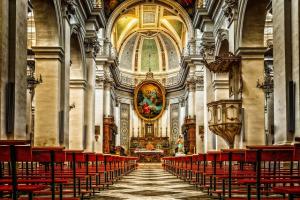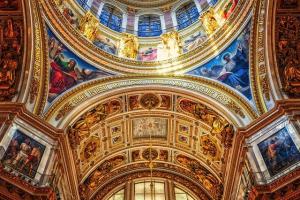The topic of beautiful churches is more complicated than you would think. It seems there’s a lot of guilt and criticism out there about the cost of churches, and serious debate about simple versus elaborate.
Recently, Claire Swinarski wrote on this topic for her Letters from a Catholic Feminist: “Longing for the Beautiful…an essay on Fancy Ass Churches.” (Nov. 15, 2021) https://thecatholicfeminist.substack.com/
Claire described a “very deep, prayerful experience” looking at a “stunning painting of the Visitation.” This experience was followed shortly thereafter by a trip to France on which she saw many amazing Gothic cathedrals, awesome stained-glass windows and gorgeous murals and mosaics.

She didn’t miss that among all the “beauty, beauty, beauty” were “row upon row of pews just waiting for you to sit and pray.” Isn’t that the purpose of churches and why we try to make them so attractive – to get people in to pray?
I’ve read that medieval churches were constructed so elaboratively because most people lived lives of such simplicity and poverty that the clergy wanted to give them a sample of heaven in church. Perhaps the message was: “Be good in this life and the next life will look like this church.”
Critics will say that this motivation was a way to teach the peasants acceptance of their lot and keep them down. A more positive view might be that, with the political and economic systems of the times being so immovable, the church was indeed the only place that peasants could share in something peaceful and beautiful.
Money for the poor, not the pompous
Nonetheless, wouldn’t the money have been better spent in providing for the poor materially instead of just spiritually? Swinarski was sickened by the contrast between the poverty still outside the churches and the opulence inside. So, should we sell off all the finery and give the proceeds to the poor?
One of my favorite books is The Shoes of the Fisherman by Morris L. West (also a movie). In it, the pope decides to sell all the Church’s treasures to alleviate a famine in China and prevent a world war.
My Catholic social justice education causes me to favor such thinking. I was once in a spectacular basilica in which the ceiling was covered in gold leaf. Mother Angelica always wanted “only the best for God” but I couldn’t justify that much money stuck to the ceiling.

If I were the rector of that church, I would be secretly up on a ladder at midnight taking out the real stuff and putting in imitation gold leaf. It would look just as good and who would know? Then I would sell the gold and use the money for the poor.
The Archdiocese of Galveston-Houston built a new cathedral in 2008. Originally, the cost was going to be well over $100M. Then we hit an economic downturn. In consideration of that, the diocese decided to do without a building extension and got the cost down to $70M.
That change showed a sensitivity to public perception and revealed what was really needed and what was not. The cathedral is still very impressive, and I assume that the intended function of the extra space has been allotted elsewhere.
Beauty Elevates
So, practicality won out in Houston. I was very glad of that, but I understand the need for beauty in a church. Swinarski came to the same conclusion. She said that, although she has “felt God deeply in tiny, simple chapels,” a prayer experience can be elevated amidst beauty that celebrates God’s goodness.
Artists have always known that beauty is an attainable and worthwhile goal. Churches signal inclusiveness by making beauty available to all as a reflection of God’s love; a gift to uplift us.

Swinarski discerned the message intended by the medieval churches: “Something in the feats of architecture and talents of the artists who sculpted such beauty reminds me of Heaven. Beauty can point us towards contemplation and say to our hearts: this is sacramental time . . . Beauty primes our hearts to have meaningful experiences with Jesus.”
She quoted Bishop Barron who said that we should “Begin with the beautiful, which leads you to the good, which leads you to the truth.” Bishop Barron added that beauty is “the arrowhead of evangelization” because people are attracted to beauty.
We’re back then to the reason for the magnificent medieval cathedrals: If you build it beautiful, they will come. Further, not only will they come, but they will likely experience a touch of heaven and be transported to a new plane of prayer and communion with God












